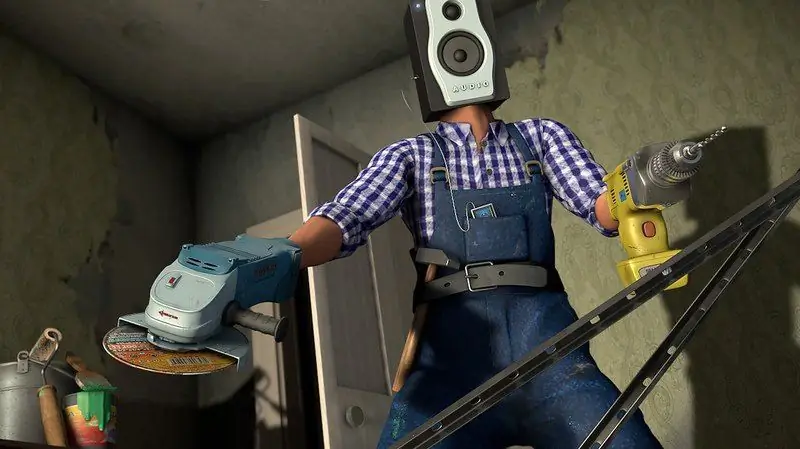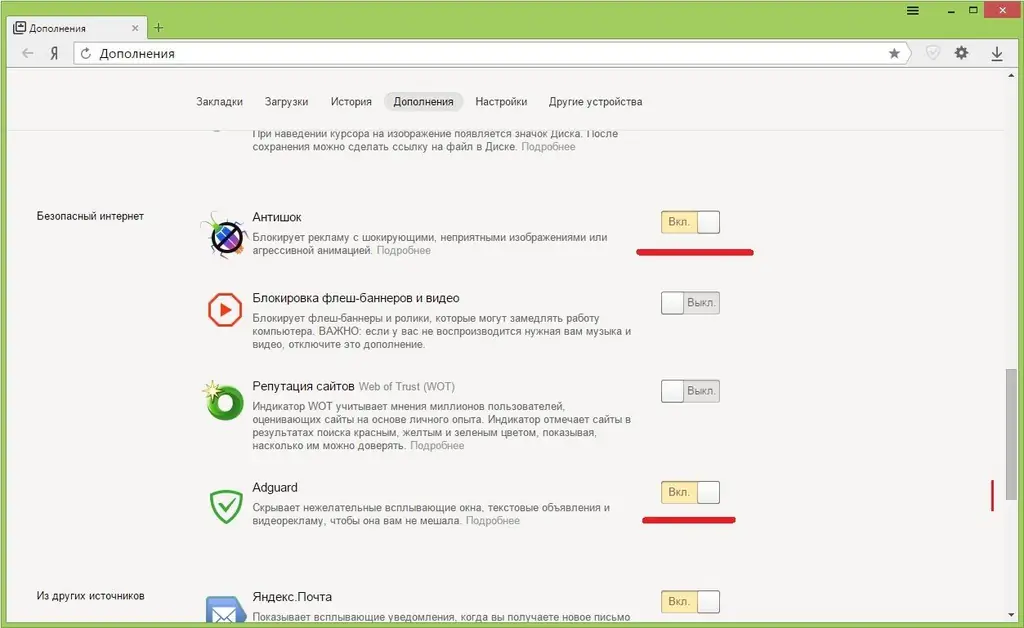
Table of contents:
- Author Bailey Albertson [email protected].
- Public 2024-01-19 10:46.
- Last modified 2025-01-23 12:41.
What to do if there is no sound in the browser: we solve the problem quickly

Suddenly, the user found that his browser refuses to play sound when playing audio or video. There are, in fact, a large number of reasons for this problem, as well as solutions. You can try opening the music or movie in a different browser, or try to fix the problem.
Content
-
1 What to do if no sound plays in the browser
- 1.1 Setting up the sound in the speakers
- 1.2 Setting up the tray
- 1.3 Restarting the browser through the "Task Manager"
- 1.4 Reboot the device
-
1.5 Clearing the browser cache
1.5.1 Video: How to Delete Data from the Google Chrome Cache
-
1.6 Update Flash plugin
1.6.1 Video: How to Upgrade Adobe Flash Player
- 1.7 Disable extensions
-
1.8 Browser update
1.8.1 Video: how to update Yandex Browser
-
1.9 Reset browser settings
1.9.1 Video: how to reset the settings of different browsers to the original
-
1.10 Upgrading sound drivers
1.10.1 Video: How to update sound card drivers
- 1.11 Enabling Windows Audio Service
- 1.12 Checking for viruses
- 1.13 Reinstalling the browser
What to do if audio is not playing in the browser
Let's consider the basic measures that any user, even the most beginner, can take: from setting up sound in the mixer and rebooting the program and PC to clearing the cache of various browsers and updating sound drivers.
Setting up the sound in the speakers
The solution may lie on the surface - perhaps you just need to turn up the volume on your speakers, if, of course, you are using them. Another PC user could set the volume to minimum or even turn off the sound or the device itself. In this case, do the following:
- Try to run another program - any player and any music or video in it. If there is no sound either, then it might be the speakers.
-
Check if the speakers are working and if they are connected to the mains and to your PC.

Increase speaker volume Try turning up the volume using a dedicated toggle switch on your speakers
- Turn on any audio recording already in the browser and turn the volume rocker on the speaker bar to the right. In this case, on the PC itself, you must also have the maximum volume. If everything is in order with the volume in the speakers (it stood at a level above average), move on to other measures.
Setting up the tray
Look at the volume icon in the Windows tray: if there is no cross on it, then the volume on the device is not at zero. However, this does not mean that the sound has not been muted separately for your browser:
- Look at the "Notification Panel" - popularly called the Windows tray. It is located in the lower right corner of the screen - the area with the clock and date. Click on the loudspeaker icon first with the left key - a panel with a slider will open. Make sure the volume is not at minimum. If the volume is almost zero, move the slider to the right or up, depending on your version of Windows.
-
Click on the same icon, but with the right mouse button. In the list, click on the first option to launch the volume mixer.

Launching the volume mixer Select the very first item "Open Volume Mixer"
-
In the mixer itself, look at the volume level that is set specifically for the browser where there is no sound. If there is a minimum or 0, lift the slider up.

Volume mixer Turn up the volume in a running browser
-
If there is a loudspeaker icon with a red crossed out circle under the scale, click on it and set the desired sound level.

No sound in the browser Click on the loudspeaker icon with a red circle to enable sound in the browser
- If you see that everything is fine with the volume, move on to other ways to solve the problem.
Restarting the browser through the "Task Manager"
The browser may experience a single crash, especially if you use it for a long time. First of all, close all unnecessary tabs - the system may have been overloaded with a large number of open pages in the browser. If that doesn't help, restart your browser:
-
Launch "Task Manager". If you have the tenth version of Windows, use the context menu of the Taskbar: right-click on it and select the item corresponding to the dispatcher in the list that appears. It will be almost at the very end.

Taskbar menu In the "Taskbars" menu, select the "Task Manager" section
-
For all other OS options, call up the blue menu via Ctrl + alt=+ Delete - in it we already click on Task Manager or “Launch Task Manager”.

Windows menu Launch the "Task Manager" through the Windows menu, which is invoked by the combination Ctrl + alt=" + Delete
-
In the first block "Processes" find the item corresponding to your browser - most likely, it will be at the beginning. Select it with the left mouse button and click on the "End task" button located at the bottom of the window.

Task Manager In the "Task Manager" find the browser, select it with the left button and click on "End task"
-
The same option to disable a task is available in the context menu: right-click on the process and select the same item “End task” in the list.

Item "End task" The option "End task" is also in the context menu of each process
- After that, open the browser again through the icon on the "Desktop", "Taskbar" or in another way.
Reboot the device
Another reboot option is to turn off and turn on the PC itself. Perhaps the problem is not with the browser process, but with system services. Restart your device correctly:
-
Click on the Start button - it is located in the lower left corner of the display. You can also click on the corresponding button on the keyboard - a similar icon in the form of a window is drawn on it.

Start button on keyboard Launch the Start Menu with a dedicated button on your keyboard
-
If you have "ten", click on the first virtual button from the bottom - with the same icon as on the physical power key on your device.

Virtual button "Shutdown" Click on the virtual button "Shutdown"
-
Select either shutdown or restart. In the first option, you will have to turn on the PC yourself.

Options for shutting down the PC Select the second or third item in the options menu that appears
-
If you have a different version of "Windows", click immediately on "Shutdown" or hover over the arrow next to it and select restart.

Completion of work Click on "Shutdown" to turn off the PC and turn it on again
Clearing the browser cache
Each browser saves different kinds of data in the cache at runtime. If you rarely delete information from there or do not clear the cache at all, most likely, your browser has already started to "junk" a long time ago, that is, to work slowly. The sound, by the way, may not work for the same reason. First, let's describe the procedure for clearing the cache for Yandex. Browser:
-
In the top right corner, find the "hamburger" icon - three parallel lines - click on it. In the called menu, click on "Settings".

Yandex. Browser menu In the "Yandex Browser" menu, click on the third section "Settings"
-
You will be taken to the inner browser tab. Scroll down immediately and click on the button to display additional options.

Show advanced settings Click on the button at the bottom of the page to expand the list with the rest of the sections
-
Immediately in the first section that appears, click on "Clear history".

Section "Personal data" In the "Personal data" section, click on "Clear download history"
-
In the new window select "for all time" from the drop-down menu. Checkmarks should be next to all items except the penultimate "Data for auto-filling forms". Click the button to start deleting history. Wait while the utility cleans up its storages.

Clearing history in Yandex Browser Check all the items except the data for autofill and click on "Clear history"
- Then restart your browser and check the sound.
Now let's look at the procedure using the example of Mozilla Firefox:
-
Click on the same icon with three horizontal lines and in the menu select the "Settings" item with the gear icon on the left.

Mozilla menu In the Mozilla Firefox menu, find and open the settings block
-
In the tab, go to the fourth section "Privacy and Security". In the third block "Cookies and site data", click on the "Delete data" button.

Privacy and Security Tab In the fourth tab, find the section with cookies and click on "Delete data"
-
In the new window, check the boxes next to the two items and click on the corresponding key to remove the button.

Deleting data in Mozilla Set two marks and click on "Delete"
-
Confirm the cleanup - files will be deleted immediately. We also restart the browser and check for sound.

Confirmation of data deletion Click on "Uninstall now" for the browser to self-clean
-
Return to the "Privacy and Security" block - find the "History" item in it. In it, click on the button to delete information about previously visited sites.

Block "History" In the block with the history of visited pages, click on the button to start deleting
-
Select "All" from the drop-down menu. Check the boxes to the left of all items except the last ones, they are optional. Start cleaning.

Data types to delete Check the first five items in the list and click on "Delete now"
If you have Google Chrome, clear the cache as follows:
-
In the upper right corner under the cross there is an icon with three dots arranged vertically - click on it to bring up the Google Chrome menu. In the list, click on the third item from the bottom under the same name "Settings".

Google Chrome menu In the browser menu, click on "Settings"
-
Go directly to the bottom of the page with the various basic settings and click on the gray "Advanced" link.

Link "Additional" Click on the "Advanced" link to reveal other sections with settings
-
In the large block "Privacy and security" the last item will be the option "Clear history" - click on it.

Item "Clear history" Click on "Clear history" to open a window with a list of sections from which you can delete information
-
Set the time range to All Time. Make sure there are check marks next to the three points and start the cleaning procedure. After that, restart the program and check if your sound problem has been resolved.

Repositories that can be emptied Select all the items and run the removal immediately
Video: how to delete data from the Google Chrome cache
Flash plugin update
The Adobe Flash Player plugin is responsible for playing media files in browsers. If he has not received an update for a long time, most likely, he will not be able to reproduce new post formats and support pages created using new methods. Try updating the plugin to see if this is the case:
-
Call the "Run" panel on the display and type the control code on it - execute the command via Enter or the OK button.

Control command In the "Open" line, manually enter or copy and then paste the command control
-
In the Control Panel window, in the second column, click the Flash Player link.

Flash Player section Open the Flash Player block in the "Control Panel"
-
In the new window, go directly to the "Updates" tab. In it, click on the "Check now" button.

Flash Player Settings Manager Dialog Box In the dialog box, go directly to the "Update" section, and then click on the "Check now" button
-
A browser tab will open - an official Adobe resource. Go to the blue Player Download Center link.

Player Download Center link Click on the Player Download Center link at the end of the text
-
On the left side of the page to download, first select your "operating system", and then the browser. See if the checkboxes are checked next to the download of the additional utility. If you don't need it, uncheck it. After that, click on the yellow "Download" button.

Download button Select OS and browser type and click on "Download"
-
Open the downloaded file - installer. The download of the necessary files and installation will start immediately. Wait for the whole procedure to complete.

Download and install a new version of Flash Player Wait until the end of the installation of the current version of Flash Player
-
After you will be asked to restart the running browser - do it. Also click on the "Finish" button to exit the installer window.

Finish button Click on the "Finish" button to close the installer window and then restart your PC
Video: How to Upgrade Adobe Flash Player
Disable extensions
The extension is a mini-utility that makes the browser more functional. For example, there are add-ons for blocking ads, enabling VPN, and many more. If many extensions are installed and activated in the browser, this will slow down the operation of the main program and cause various problems, including loss of sound. Try to disable, at least for a while, add-ons that you don't need right now. First, let's describe how to do this in Google Chrome:
-
We click on the menu icon with three dots - in it we open the list of "Additional tools". In the list, click on the item with extensions.

Additional tools Open the menu "Additional tools", and in it there is already a section "Extensions"
-
An inner tab with installed add-ons will open. We carefully study the list and turn off the mini-programs in turn. At the same time, we constantly check if the sound has turned on. You can also deactivate all add-ons at once, restart the browser after that and see if the problem has been resolved.

List of Google Chrome extensions Remove or disable unnecessary extensions in the inner browser tab
- If there are any add-ons that no one has used for a long time, we delete them using a special button.
How to get to the list with mini-utilities in Yandex Browser, we will consider in the following instructions:
-
Expand the browser menu through the hamburger icon. Immediately click on the "Add-ons" section.

Item "Supplements" In the Yandex Browser menu, open the Add-ons block
-
In the tab, slowly scroll through the list of extensions to familiarize yourself with them. Determine which you do not need and click on the radio button on the right for each such add-on. Deactivate everything if possible.

List of Yandex Browser extensions Disable unnecessary extensions using the switch
-
If you want to remove an extension, click on the "Details" link and then on the corresponding button in the menu that appears. However, you can remove only those extensions that you installed yourself earlier. You cannot delete the standard ones.

Removing an extension To remove a third-party add-on, click on "More" and then on "Remove"
- Reload the program and see if there is sound.
Finding a block with extensions in Mozilla is also quite simple:
- Launch the surf tool menu and click on the "Add-ons" component. You can open the desired section using the three-key combination Ctrl + Shift + A.
-
In the tab, go directly to the second section "Extensions" to go to the list of already installed programs.

List of extensions in Mozilla In the list of extensions, find those you don't use and disable them
-
Deactivate or remove all add-ons using the corresponding buttons.

Removed add-ons It's best not just to disable all unnecessary mini-programs, but to uninstall them
Browser refresh
The lack of sound in the browser can also be explained by the fact that this program does not have enough updates. Modern browsers receive updates, as a rule, automatically, but for one reason or another, the update may never take place. For example, the system was unable to download the required files due to the lack of internet. Therefore, it is necessary to manually check whether the program needs an upgrade or not. Let's also look at the procedures for several browsers. Let's start with Mozilla:
- Open the "Settings" tab through the browser menu - we talked about this in the section on clearing the cache in this article.
-
In the first block with basic parameters, scroll down to the "Firefox Updates" section. You can see a message that the current version of the utility is currently installed. Anyway, click on the button opposite to start the search.

Basic tab In the "General" tab, find the "Firefox Updates" block and click on the button to start the check
-
The browser will try to find updates on its official resource. Wait for the procedure to finish - it usually does not last long.

Find Firefox Updates Wait a little while the browser finishes searching for updates on the network
- If any new versions of the program are found, the browser will immediately download them and then install them. After that, the program will ask you to confirm restarting it. If they are not there, you will see the same message about the relevance of the version. This means it's not about updates.
Now let's analyze the option for the Google Chrome program:
-
We click all on the same icon with three dots, but this time we just move the mouse arrow over the second item from the bottom called "Help". In the called additional list, click on the first item "About the browser".

Help Menu In the "Help" menu, run the section "About the Google Chrome browser"
-
In a new tab, you will see that the application immediately started looking for an update on the network. We are waiting for its end.

Check for Updates Wait for Google Chrome to finish checking for an update on its official resource
- As in the case of "Mozilla", if an improved version is found on the official resource, it will be installed immediately without user intervention, and the browser will be restarted. Otherwise, you will be notified that the latest version of Google Chrome is installed on your PC.
There is one more Yandex Browser for consideration. In it, the update takes place in the same way as the update of Google Chrome:
-
Click on the menu button in the top right corner of the screen and just hover the cursor over the last "Advanced" object, and in its menu, click on the "About browser" item.

Advanced menu In the list "Advanced" select "About browser"
- The search for updates will start immediately on the new page. It will take a few seconds. We are waiting for the end and we are looking at the result.
-
If there is an update, there will again be an immediate download and installation. If it is absent, a message will appear about the relevance of the available option.

Current browser version If there are no updates available for download on the network, the program will inform you about this after the end of the search
Video: how to update Yandex Browser
Reset browser settings
The sound problem may be caused by unauthorized changes to any settings in your browser. This can be done by various utilities that you previously installed on your PC, as well as viruses that have penetrated the "operating system". In this situation, it is necessary to reset all parameters - the browser will return to its original state, in which it was immediately after installation.
Depending on the browser, different types of data may disappear during the reset: all tabs, third-party extensions, saved passwords, temporary files in the cache, and other information. Let's start the description of the procedure from the Google Chrome browser:
- Navigate to advanced browser settings using the instructions in the clearing the cache section of this article.
-
Scroll down the list of options to the section on resetting settings and removing viruses. Click on "Restore Default Settings".

Restoring default settings Run Restore Default Settings
-
Confirm that you want to return the initial state of the browser, which was immediately after its installation.

Reset settings in "Google Chrome" Click on "Reset settings"
- The browser will immediately execute your command. After restarting the program, make sure the sound appears.
Resetting all parameters to "factory" settings in Yandex Browser has the same principle:
-
Open the settings through the browser menu, and then go to the advanced settings at the bottom of the page. At the very end of the list you will find the "Reset settings" button - click on it.

Reset settings button Click on the "Reset Settings" button at the end of the page
-
Confirm your intention in the dialog box.

Confirmation of factory reset Click on the "Reset" button in the dialog
- The browser will restart. After that check if the audio is working.
The procedure for returning the initial parameters in Mozilla will differ from the previous two:
-
In the Firefox menu, expand the Help section. In it, click on the "Information for problem solving" block.

Troubleshooting Information Select "Troubleshooting Information" from the Start menu
-
In the new tab, immediately click on "Clean" under the phrase "Tweak Firefox".

Refresh Firefox button Click the Refresh Firefox button
-
In the dialog box, agree to return the "factory" parameters.

Clear and reset confirmation Confirm that you want to reset Firefox preferences
-
The utility window will immediately close - the reset will begin. Wait for it to finish.

Refresh Firefox Wait until the end of cleaning and resetting the Mozilla settings
-
When everything is ready, the browser will reappear on the display. Select one of the two options for restoring tabs and click on "Next". Turn on the media file in your browser to test the sound.

Completed cleaning Select the desired item about restoring tabs and click on "Next"
Video: how to reset the settings of different browsers to the original
Upgrading sound drivers
If there is no sound not only in the browser, but also in other utilities, for example, players, and if even system sounds are missing, it may be because of the audio drivers installed on the PC. Most likely they require an update:
-
First, you need to call the system service "Device Manager" on the display. If you have the tenth version of "Windows", just click on the "Start" button with the right mouse button - find and open the dispatcher in the large list.

Start button context menu Click on "Device Manager" in the context menu "Start"
-
If you have a "seven" or another version, find the shortcut "My Computer" on your "Desktop" and also right-click on it - select the last component "Properties" in the list.

Item "Properties" Click on "Properties" in the shortcut menu "My Computer"
-
On the panel with information about the "operating system" in the left part there will be a link to the dispatcher - go to it.

System information window In the left part of the window, click on the link "Device Manager"
-
In the dispatcher window, find and expand the item with audio and video equipment.

Item Realtek High Definition Audio Click on the item Realtek High Definition Audio and select "Update device"
- Right-click on the main audio driver of your device - start the update wizard by clicking on the first item.
-
In the wizard, select the automatic search for an update for "firewood".

Automatic search for updates Start automatic search for updates
-
Wait for the end of the search.

Driver search Wait for the search for drivers on the network to end
-
If an update is found, the operating system will install it on the PC on its own and ask you to restart it. If the updates are not available online, a message will appear stating that the current driver is current. Click the Close button to exit the wizard.

Drivers relevance If the system does not find anything, you will see a message stating that the current drivers are installed on the PC
- If the automatic tool does not find anything, you can download the driver manually from the official resource of your PC manufacturer or the sound card itself. In this case, you will need to find out the exact model name of the card or device in order to ensure that the correct driver is downloaded and installed. Otherwise, you run the risk of aggravating the sound problem.
- Try updating the configuration in the standard manager as well. Right-click on the sound driver and this time choose the "Remove device" option. Confirm your action.
-
After that, in the "Action" menu on the top panel of the manager, click on the item to start the configuration update.

Hardware configuration update Click on the option "Update hardware configuration"
Video: how to update sound card drivers
Enabling Windows Audio Service
If there is no sound on the device as a whole, and not only in the browser, and the "firewood" update did not give any results, check if the service for audio playback is activated at all on your PC:
-
In the "Run" window for searching folders, programs and resources, which is called by the Win and R keys, run the services.msc command.

Services.msc command In the "Open" field enter services.msc and click on OK
-
In the System Services window, find the Windows Audio component and double-click on it to bring up a dialog box with settings.

Services window Double click on Windows Audio service
- In the window, set automatic activation in the "Startup type" menu.
-
We start the services using a special button and do not forget to save all the changes - click first on "Apply" and then on OK.

Launch type Set the startup type to "Automatic"
Check for viruses
Various malware can interfere with the sound not only in the browser, but also on the PC as a whole. Check if your device has viruses and, if necessary, disinfect the system. Let's describe the process step by step using the example of Kaspersky Anti-Virus:
- Launch its window through a shortcut in the Start menu or on the Desktop. You can also use the Windows tray - in the lower right corner of the display there is an arrow pointing up. Look for the Kaspersky icon in the small window.
-
Click on the "Check" tile at the bottom of the antivirus window.

Check Tile Click on the "Check" tile
-
On the next page, run a full scan.

Full check Choose full scan to get a reliable scan result
-
Wait until the check is over - it will take a lot of time. If the antivirus detects dangerous files on the hard drive along the way, you will find out about this in the window.

No threats After checking, it may turn out that there are no viruses on the PC
- When the scan is successfully completed, a report with the results will appear in the window. If there are viruses, the utility will give you a list of possible actions with them. Select delete.
- Restart your PC and check if there is sound. If it is not there either, try restoring system files in the "Command Prompt".
Reinstall your browser
If none of the above methods worked, try reinstalling your browser. First, it must be removed correctly. Using standard tools will not help here, you need to use a third-party utility - an uninstaller. It will delete not only basic information from the hard disk, but also residual files - registry entries, profile data in the browser, etc. Removing any browser follows the same principle.
Let's consider the procedure using the example of Mozilla Firefox and the Revo Uninstaller, a program with a simple Russian interface that works for free:
-
Launch the official page for downloading the Revo Uninstaller installer file. Download the free version from it - click on the Free Download button.

Revo Uninstaller official website Click on the Free Download button to download the utility installer
-
In a new tab, click on Download again and wait for the download to finish. We open the document and install the utility on the PC, following the simple instructions in the wizard window.

Downloading the Revo Uninstaller Click on the Download button to start downloading Revo Uninstaller
-
Run the utility through a shortcut on the "Desktop" or in the "Start" menu. In the system window, give permission to the uninstaller to apply any changes to the system.

Permission to make changes Click on "Yes" to allow Revo Uninstaller to make changes on your PC
-
In the first section for uninstallation, we find in the list the browser that we want to remove completely from the PC memory. Select the item with the left button and click on the "Delete" icon located on the top panel.

Revo Uninstaller window Find in the Revo Uninstaller window the browser in which the sound does not work
-
We are waiting for the application to create a restore point.

Create a restore point Wait for the restore point creation to complete before uninstalling the program
-
After that, the utility will launch the built-in browser uninstaller to remove the basic information. Click on "Next".

Built-in browser uninstaller Click on "Next" in the initial window of the uninstaller
-
We confirm the deletion and wait for the procedure to complete. Click on "Finish" and go back to Revo Uninstaller.

Run browser uninstall Click on "Remove" to start the process
-
Select the provincial level of scanning for residual files with a round mark and start the scan.

Selecting the scanning level Select the verification level and click on "Scan"
-
First, the application will find the remaining registry entries associated with the browser. Select all the items and click on "Delete".

Removing registry entries Highlight all registry entries and delete them
-
We confirm the deletion in a small dialog box.

Confirmation of deletion of all records Confirm that you want to delete all browser-related registry entries
-
After that, Revo Uninstaller will detect the remaining files and folders on the disk. In the same way, select everything and delete.

Removing residual files Select all residual files and click on the "Delete" button
- Reboot your PC.
Now you can proceed to reinstall the browser. Immediately load the just removed Mozilla Firefox:
-
Through any other browser, go to the official page for downloading Mozilla. There will be a bright green download button on the left - click on it.

Mozilla Firefox official page Click on "Download Now" to download the browser installer
-
Run the installer through the panel with the downloaded files.

Downloads panel Open the downloaded file in the Downloads panel
-
The installation will begin immediately - the installer will do everything without you. You just have to wait. When the procedure is complete, the browser will automatically start. Check right away if the sound works in it.

Installing Mozilla Firefox Wait for the installer to install Mozilla on its own
Now we will describe the installation of "Google Chrome". The procedure is just as simple:
-
Open the official website of the browser and click on the central blue button "Download Chrome".

Google Chrome official page Click the Download Chrome button
-
Accept the terms of the agreement in the dialog box.

Acceptance of the terms of the agreement Click on the blue button "Accept the Agreement"
-
Run the installer and wait a while while it completes the installation. When the procedure is successfully completed, a clean Google Chrome browser will open, in which the sound should already work.

Downloading files for installation Wait for Google Chrome to download and install files
Finally, let's take a look at reinstalling Yandex Browser:
-
Follow the link to download the installer from the official resource and click on the yellow button to start the download.

Official site of "Yandex. Browser" Download the Yandex. Browser installer on the official resource
-
Run the file and click on "Install". If you want, you can immediately make Yandex Browser your default browser.

Install button Click on the yellow "Install" button to start the installation
-
We are waiting for the installer to install the utility. When everything is over, its window will appear on the display.

Installation process We are waiting for the completion of the procedure - it will take a little time
Missing audio in the browser can be recovered in many ways. Depending on the reason, both a simple restart of the utility and clearing its cache along with updating the sound "firewood" can help you. It is impossible to immediately understand why the sound disappeared, so you need to apply method after method.
Recommended:
What To Do If The IPhone Or IPad Is Dead And Won't Turn On Anymore: Solutions To The Video Problem

How to restore the power scheme of an iPad or iPhone if it won't turn on when charging. Step by step instructions for repair. How to avoid future charging problems
Neighbors From Above Roll And Drop Metal Balls: Why This Sound Occurs

Why is there a sound as if the neighbors from above are rolling and dropping metal balls?
How To Completely Remove The Amigo Browser From Your Computer - Instructions And Tips With Photos And Videos

Stages of removing explicit and hidden files of the Amigo browser, including from processes and startup. What to do if the browser is installed again after uninstallation
How To Install An Extension In Yandex Browser - What Are There, How To Download, Configure, Uninstall And What To Do If They Don't Work

Why install add-ons in Yandex Browser. How to download them from the official store or from the developer's site. What to do if not installed
What To Do If The Video In The Browser Slows Down - The Causes Of The Problem And Possible Solutions

Why does the video in the browser slow down? How to fix it: killing processes, cleaning startup, checking internet speed, clearing browser cache, etc
